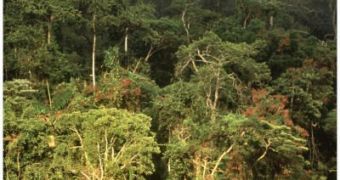1. Plants have in their structure xylem tubes that transport water and mineral salts and phloem tubes that carry the food. Both types of tubes are produced by a meristematic tissue called cambium. Xylem is produced inward, phloem outward. Death xylem layers form the wood.
2. The green pigment called chlorophyll allows the photosynthesis through which plants synthesize sugars coming from water and carbon dioxide. Even brown or red leaves contain chlorophyll. Only parasite plants, like dodders and fungi lack chlorophyll. Sugars stock sun energy. In greenhouses, artificial light and supplementary carbon dioxide boost photosynthesis. But plants also need nitrogen, phosphorus, magnesium, iron, calcium and potassium, plus minor amounts of other elements, for synthesizing all the necessary organic chemicals. Most plants store energy as starch.
3. Plants breathe all the time, breaking down the sugars for getting energy. Plants also sweat, mainly through their leaves. Water goes out through small pores called stoma. This creates an absorption force transmitted to the roots. In wet environments, plants sweat less, but in dry, windy areas, the water loss is high. Plants adapted to dry and hot weather lack leaves (cacti) or have special changes in their leaves that impede water loss, like thick cuticles and less stoma whose opening can be controlled.
4. Plants growing in the shadow have larger leaves; plants can also direct their leaves towards the light source, a phenomenon called phototropism. Because plants lack a nervous system, plants' reactions are controlled by hormones. Gibberellins are involved in stimulating plants' growth, while abscisic acid inhibits the plant growth, causing the leaves and mature fruits to fall.
Geotropism is the plant's reaction to gravitation: their roots always grow downward. Chemotropism is the plant's reaction to chemicals, like auxins, hormones that control plants' development and the growth rate of various parts. Auxins are concentrated in roots and shoots. Too much auxin inhibits the growth. If a plant is placed horizontally, auxins accumulate in the lower part, causing the curbed vertical growth of the plant.
Auxins are more concentrated in the shadowed part of the plant; this way they stimulate those cells to grow more rapidly, turning the shoot towards the light. This is a method through which a hormone creates movement. Auxins are involved also in the opening of the flowers, being influenced by light and temperature. Heat makes the petals grow faster causing the opening of the blossoms while the cold can revert this process.
In vines, the growth hormones concentrate into the opposite side to the support, fact that causes the curly growth around the support. As auxins control the shoots' development, they generate the bushy (or not) aspect of a plant. When shoots are cut or destroyed, the auxins levels decrease, turning on "sleeping" buds that produce new shoots.
5. Plants growing in the tropical areas experience relatively short daylight all round the year, while those from higher latitudes experience very long daylight during the vegetation time in the summer. That's why tropical plants cultivated in temperate areas, like Dahlia brought from Mexico, will flower during the shorter autumn days.
6. Today, there are about 400,000 species of plants. First plants going out of the water (mosses and ferns) are still connected to wet environments, due to physiological and reproductive reasons. First flowered plants (gymnosperms) depended on wind for pollination and seed dispersal. Angiosperms (fruit plants) evolved with the pollinating insects.
7. The oldest known "plants" are 3.1 billion years old blue-green "algae" (a type of photosynthetic bacteria). These plants still form scums on lawns or forest trails and are the first organisms to have made photosynthesis. Bacteria can divide in 20-30 minutes, and a sole cell can produce hundreds of millions of bacteria in 10 hours. Most bacteria have about 0.00001 mm in length.
8. About 1.5 billion years ago, the first real unicellular algae appeared. They still make most of the phytoplankton. Euglena, a unicellular alga, can also feed the way animals do. Today, unicellular algae grow from the oceans to lakes and wet places (like shadowed walls). 590 million years ago, there were over 900 species of large pluricellular algae ("sea weeds"). Likens are symbioses between an alga and a fungus. They are so resistant, that they can live at 5,600 (19,000 ft) in Himalaya and are the first pioneers of barren rocks or colonize tree trunks or bones. Some likens are used for achieving turnsole, a chemical indicator that turns red in acid solutions and blue in alkaline solutions.
440 million years ago, freshwater algae started to conquer the land. They got rigid tissues and the vascular tubes (xylem and phloem). Their bodies still resembled an alga body, lacking roots or leaves, and reproduced through spores that required humidity. These early vascular plants inhabited swamps.
Mosses have structures resembling leaves or stems, but they do not have vascular tissues and are strictly connected to wet places.
In ferns, the sporophyte is less dependent on humidity, but the gametophyte developing from the spores requires humidity. 360 million years ago, huge tree ferns related to the horse Tails united in extensive forests that formed coal deposits. Pteridosperms (seed ferns) appeared 248 million years ago, they resembled ferns, but eliminated the gametophyte, producing seeds on the tip of their branches.
Gymnosperms have seeds, but do not form fruits. They dominated the Mesozoic Era, when dinosaurs ruled the Earth, starting about 290 million years ago, when Earth was dominated by Ginkgo relatives, coniferous trees, and Cycas relatives. Redwoods, which are coniferous gymnosperms, are the world's largest trees.
Most living plants are angiosperms and angiosperms make (almost) all our plant food (if we except some alga intake), from cereals to fruits and vegetables. They appeared 140 million years ago, during the Cretaceous (the last dinosaur era), and since then, they have been dominating the world's vegetation. Angiosperms have the seed wrapped in a fruit, and are adapted to various pollinators and methods of seed dispersal.

 14 DAY TRIAL //
14 DAY TRIAL //